
The Rubiaceae are a family of flowering plants, commonly known as the coffee, madder, or bedstraw family. It consists of terrestrial trees, shrubs, lianas, or herbs that are recognizable by simple, opposite leaves with interpetiolar stipules and sympetalous actinomorphic flowers. The family contains about 13,500 species in about 620 genera, which makes it the fourth-largest angiosperm family. Rubiaceae has a cosmopolitan distribution; however, the largest species diversity is concentrated in the tropics and subtropics. Economically important species include Coffea, the source of coffee, Cinchona, the source of the antimalarial alkaloid quinine, some dye plants, and ornamental cultivars.

Gentianales is an order of flowering plants, included within the asterid clade of eudicots. It comprises more than 16,000 species in about 1,138 genera in 5 families. More than 80% of the species in this order belong to the family Rubiaceae.
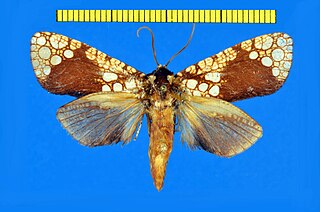
Dudgeonea is a small genus of moths and the only genus of its family, the Dudgeoneidae. It includes six species distributed sparsely across the Old World from Africa and Madagascar to Australia and New Guinea.

Galium is a large genus of annual and perennial herbaceous plants in the family Rubiaceae, occurring in the temperate zones of both the Northern and Southern Hemispheres. Some species are informally known as bedstraw.
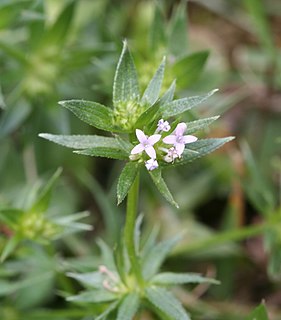
Sherardia is a monotypic genus of flowering plants in the family Rubiaceae. The genus contains only one species, viz. Sherardia arvensis or (blue) field madder, which is widespread across most of Europe and northern Africa as well as southwest and central Asia and Macaronesia. It is also reportedly naturalized in Australia, New Zealand, Taiwan, Kerguelen, Ethiopia, Sudan, southern Africa, Mexico, Costa Rica, South America, Bermuda, Cuba, Haiti and much of Canada and the United States.

Psychotria is a genus of flowering plants in the family Rubiaceae. It contains 1,582 species and is therefore one of the largest genera of flowering plants. The genus has a pantropical distribution and members of the genus are small understorey trees in tropical forests. Some species are endangered or facing extinction due to deforestation, especially species of central Africa and the Pacific.
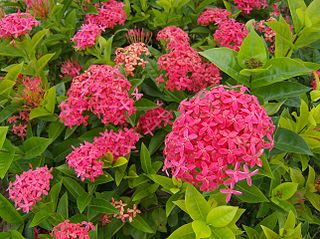
Ixora is a genus of flowering plants in the family Rubiaceae. It is the only genus in the tribe Ixoreae. It consists of tropical evergreen trees and shrubs and holds around 562 species. Though native to the tropical and subtropical areas throughout the world, its centre of diversity is in Tropical Asia. Ixora also grows commonly in subtropical climates in the United States, such as Florida where it is commonly known as West Indian jasmine. Other common names include viruchi, rangan, kheme, ponna, chann tanea, techi, pan, siantan, jarum-jarum/jejarum, jungle flame, jungle geranium, and cruz de Malta, among others. The plants possess leathery leaves, ranging from 3 to 6 inches in length, and produce large clusters of tiny flowers in the summer. Members of Ixora prefer acidic soil, and are suitable choices for bonsai. It is also a popular choice for hedges in parts of South East Asia. In tropical climates they flower year round and are commonly used in Hindu worship, as well as in ayurveda and Indian folk medicine.

Canthium is a genus of flowering plants in the family Rubiaceae. They are shrubs and small trees. The leaves are deciduous and the stems are usually thorny.

Lasianthus is a genus of flowering plants in the family Rubiaceae. They are tropical subshrubs, shrubs, or rarely, small trees. They inhabit the understory of primary forests. None of them are known to have any use.

Palicourea is a plant genus in the family Rubiaceae. It contains about 200 species, which range from shrubs to small trees, and is distributed throughout the New World tropics.

Burchellia is a monotypic genus of flowering plants in the family Rubiaceae. The genus contains only one species, viz. Burchellia bubalina, which is endemic to southern Africa: the Cape Provinces, KwaZulu-Natal and the Northern Provinces in South Africa, and Eswatini. It is commonly known as "wild pomegranate" (English) or "wildegranaat" (Afrikaans).

Vanguerieae is a tribe of flowering plants in the family Rubiaceae and contains about 640 species in 28 genera. It is one of the most species-rich groups within the family and it is distributed all over the Paleotropics.
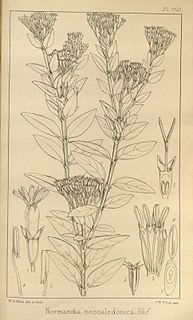
Normandia is a monotypic genus of flowering plants in the family Rubiaceae. It was described by Joseph Dalton Hooker in 1872. The genus contains only one species, Normandia neocaledonica, which is endemic to New Caledonia. The genus is related to Coprosma and Nertera.
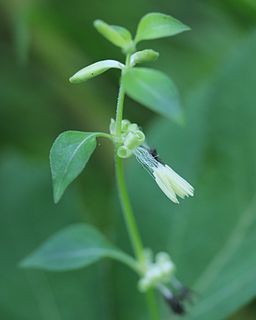
Theligonum is a genus of flowering plants in the family Rubiaceae. It was described by Carl Linnaeus in 1753. The genus is found from Macaronesia to the Mediterranean Basin, and from China to temperate eastern Asia. It is the only genus in the tribe Theligoneae.

Ixoroideae is a subfamily of flowering plants in the family Rubiaceae and contains about 4000 species in 27 tribes.

Crossopteryx is a monotypic genus of flowering plants in the family Rubiaceae. The genus contains only one species, viz. Crossopteryx febrifuga, which is found in tropical and southern Africa.
Deccania is a monotypic genus of flowering plants in the family Rubiaceae. The genus contains only one species, viz. Deccania pubescens, which is endemic to India.
Dunnia is a monotypic genus of flowering plants in the family Rubiaceae. The genus contains only one species, viz. Dunnia sinensis, which is endemic to Guangdong.
Trailliaedoxa is a monotypic genus of flowering plants in the family Rubiaceae. The genus contains only one species, viz. Trailliaedoxa gracilis, which is endemic to south-central China. It is also the only species in the tribe Trailliaedoxeae.
Augusteae is a tribe of flowering plants in the family Rubiaceae and contains 89 species in 3 genera. Augusta is found from Mexico to Brazil and in the southwestern Pacific region, Wendlandia is found in northeastern tropical Africa, tropical and subtropical Asia and Queensland, and Guihaiothamnus is found in South China.














